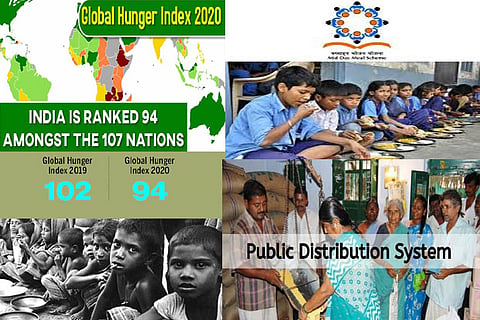

Chennai
The report said 14 per cent of the country’s population is undernourished, putting it in the ‘serious’ category alongside neighbours such as Bangladesh, Myanmar and Pakistan, ranked 75, 78, and 88 respectively. India which ranked 102 out of 117 countries last year, has found itself in this position owing to poor implementation of processes as well as lack of monitoring, experts say.
The report also sheds light on critical aspects of nutrition regarding children. The stunting rate, an indicator of chronic under-nutrition that results in low height, among children under 5 is 37.4 per cent. And wasting rate, an indicator of low weight regarding height was pegged at 17.3 per cent in the same age group. The UN has said that as many as 368.5 mn children in 143 countries who are dependent on meal programmes for their daily intake of food, will face malnutrition during COVID-19.
In India, this affects 120 mn children hailing from economically challenged backgrounds who rely on the midday meals offered in government schools and anganwadis. When such institutions shut down during the lockdown, the Centre introduced a plan to provide families with dry rations instead of school meals. States had received ad-hoc funds to the extent of Rs 2,566 cr for fiscal 2020-21 under the Mid-Day Meal Scheme of the Education Ministry. However, as per the National Human Rights Commission (NHRC), cash transfers and distribution of dry rations could not be commenced in many states as schools and anganwadis remained shut.
Ironically, India has some of the strongest Central mechanisms to address nutritional deficiencies, including the world’s largest school meal programme, the Integrated Child Development Services (ICDS) which controls the anganwadi (child and maternal health) centres, as well as the Public Distribution System or PDS, under the National Food Security Act (NFSA). Even the New Education Policy 2020 has emphasised the importance of meals for children and has factored in school breakfasts as part of its initiatives.
So, what exactly is ailing India on the nutritional front? The Harvard Chan School of Public Health has listed out risk factors including extreme poverty, poor dietary diversity, lack of education among mothers, and short maternal stature. As much as 22 per cent of the population lives below the poverty line. And most of these women suffer from malnutrition. Quite simply, an undernourished mother will give birth to a less-than-healthy baby.
There is a need for a unified approach on part of both the States and Centre to tackle malnutrition. A coherent framework of resource deployment that sees participation from, and data sharing among various ministries such as Women and Child Development, PDS, Rural Development, and Health and Family Welfare needs to be put in place. Targeted nutritional awareness campaigns can help mothers make more informed dietary choices for the children (vis-a-vis breastfeeding for the first six months). The quality of mid-day meals also must be enhanced – both in terms of fortification and hygiene. Investments in social welfare schemes, including universal access to infant and young child care as well as maternal health care, must be prioritised, and made accountable in the days to come. If India is to stand tall in the future, the right nutrition could well be the starting point.
Visit news.dtnext.in to explore our interactive epaper!
Download the DT Next app for more exciting features!
Click here for iOS
Click here for Android